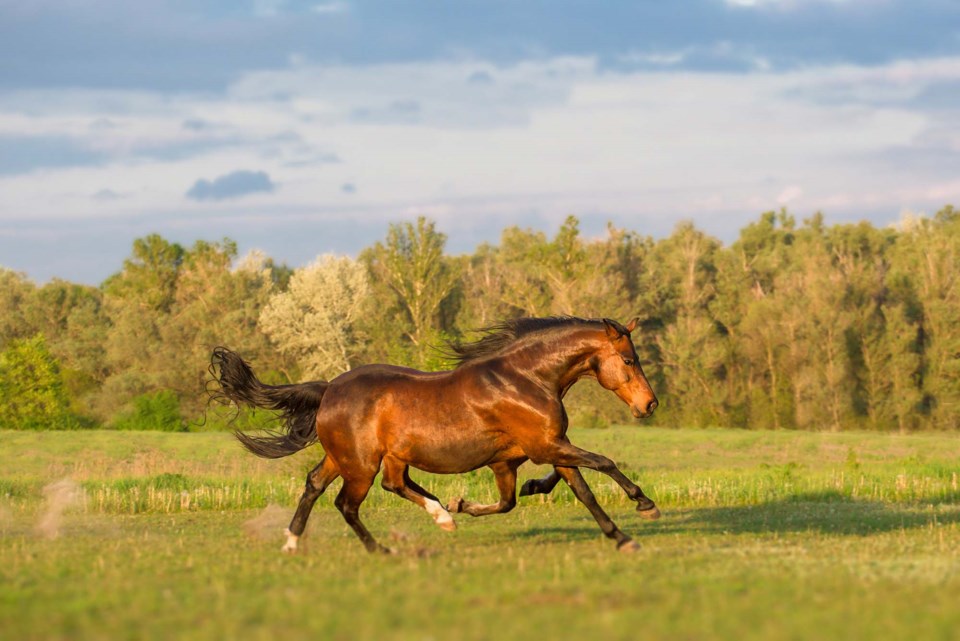Scientific St. Albert
The Gazette is using science to answer questions from students of all ages about the world around them. Send in your questions to [email protected].
Spiders are fast. So are horses. Could we make a horse faster if it was more like a spider?
Alexis, a Grade 2 student at Wild Rose, may have been thinking along these lines when she asked Scientific St. Albert, “If horses had more legs, could they run faster?”
A matter of trade-offs
A horse’s speed is determined by its stride length, stride rate, stride angle, and the fitness of its respiratory and circulatory systems, reports Horse Sport magazine. If a horse can take bigger steps more often, it will go faster. Most professional horse racers use diet, genetics, and training to get more speed out of their rides, rather than extra legs.
Michael Günther, a physicist with the Institute for Modelling and Simulation of Biomechanical Systems at the University of Stuttgart, co-authored a paper in 2020 that laid out how to calculate the top speed of any legged animal, including a giant spider like Shelob from The Lord of the Rings (15.7 m/s, if you’re curious)
Muscles, in theory, should determine speed, as they generate the force needed for movement, Günther said.
“If you are growing bigger, your (muscle) fibres become longer on average,” he said, so bigger creatures tend to be faster (in absolute terms) than smaller ones.
So why aren’t elephants faster than cheetahs? The bigger you get, the more friction you experience from the air and your muscle fibres rubbing against each other, which saps your speed, Günther said. Bigger muscles also weigh more — double a muscle’s length, and you octuple its mass. More mass means more inertia, and more energy needed to swing your legs back and forth. His team determined that once a creature weighs more than about 100 kg, it can no longer gain more speed through additional muscle mass.
This also limits the speed boost you can get from longer legs, Günther explained. A spider has about 12 per cent of its mass in its legs, while a human has about a third of its mass in its legs. Make a human’s legs longer and keep muscle power constant, and you have a longer stride but less propulsive power per step. Add more muscles, and you have heavier limbs that are slower to move.
“If you change something in the body on one side, it has influence on the rest of the body in its design,” Günther said.
More leg, more speed?
But what about more legs?
Having four legs gives you more speed than two (generally speaking) if you have a flexible spine like a horse, Günther said. By flexing their spines, horses artificially lengthen their legs to take bigger steps, resulting in more speed. Without a radically redesigned spine, a horse could not use this extension trick if it had more than four legs.
Very small creatures, such as spiders, do not have flexible spines and can’t use this trick, Günther said. Instead, small creatures use multiple limbs to push against the ground so they are always generating thrust, and keep those limbs crouched so they don’t have to swing as far per step.
But a crouched stance is only possible if you have a light body, Günther continued. If a horse tried to move while crouched, it would collapse, as its legs could not support its weight. Beef up the legs to compensate, and you have heavier, slower legs.
Adding more legs to a horse would add to its mass, inertia, and friction, increasing the amount of energy it would have to spend to get moving and counteracting any speed boost, Günther said. It would also increase its risk of stumbling, as its legs would have less space to move in without tripping over each other. You could try to trim its mass by shaving weight off the rest of the horse, but this could result in a “live fast, die young” horse with a reduced lifespan.
A spider-sized horse would have other issues, Günther said. Horse-sized tendons are able to store energy like springs when they strike the ground, which reduces power demand on the horse’s body. A spider-sized horse would lose this advantage, as at that size friction overpowers the energy storage of the tendons.
Mechanical matters
Scientists face these same trade-offs when they build robots, said Matthew Taylor, director of the Intelligent Robot Learning Lab at the University of Alberta. You can put 40 legs on your robot, but that means it will be harder to control and need more energy to move.
“If you have more legs, they better be able to give you more power overall without adding weight,” he said.
The fastest land animals on Earth are those with four legs, Günther said. You could build a really fast robot spider if you had super-strong motors and ultralight materials, but researchers have yet to make a motor that is more efficient than muscle tissue.
Günther said questions about horses and legs can inspire researchers to create better materials and robot designs.
“It opens the mind to see what it takes to design the whole system.”




